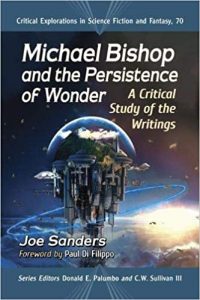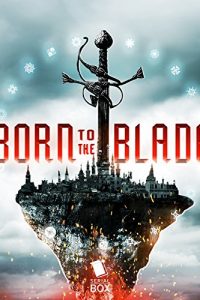Alvaro Zinos-Amaro Reviews Michael Bishop and the Persistence of Wonder by Joe Sanders
 Michael Bishop and the Persistence of Wonder: A Critical Study of the Writings, Joe Sanders (McFarland 978-1476671512, $39.95, 202pp, pb) January 2021.
Michael Bishop and the Persistence of Wonder: A Critical Study of the Writings, Joe Sanders (McFarland 978-1476671512, $39.95, 202pp, pb) January 2021.
Paul Di Filippo concluded his thoughtful review of Michael Bishop’s The Sacerdotal Owl and Three Other Long Tales (2018) by recommending that Bishop be considered for a Damon Knight Memorial Grand Master Award, and I’d like to echo that sentiment here. Besides Bishop’s rich body of work, Joe Sander’s new book, which provides a thorough discussion of Bishop’s novels and major short stories over the last fifty years, serves as a persuasive exhibit in favor of such a nomination. Di Filippo, who shares nearly as many years of “comradeship,” as he puts it, with Bishop, and with whom he has collaborated on two mystery novels published under the name of Philip Lawson, provides the Foreword to the current volume. Therein he cites Bishop’s “questing spiritual intelligence,” a useful phrase to keep in mind when evaluating Bishop’s career. Sander’s study contains two chapters on Bishop’s short fiction (1970-1980; 1981-1994), two on the novels (1975-1980; 1982-1994), and a fifth on fiction from 1995 through the present. By alternating between short stories and novels, and, grossly speaking, proceeding in chronological fashion, Sanders is able to develop his critical insights in a contextually comprehensive way while also highlighting the thematic and structural connections between numerous pieces, as when, for instance, he remarks that “Dogs’s Lives” (written 1974; pub. 1984) and “Life Regarded as a Jigsaw Puzzle of Highly Lustrous Cats” (1991) both consist of fragments in need of “assembly by readers.” Given the story titles and Bishop’s often dark sense of humor, that connection is perhaps not surprising.
One of the benefits of this overview is its wide-ranging scope, which brings key themes in Bishop’s writing to the fore. Philip K. Dick Is Dead, Alas (1978) stresses that “writing and reading imaginative literature can make a difference,” while the interpolated stories in Eyes of Fire (1980) illustrate how fiction provides “a way to discover shapes that let us grasp our confusing, disturbing experience.” Along similar lines, one of the main concerns of Count Geiger’s Blues (1992) is “our struggle to create art.” Sanders’s analysis of Unicorn Mountain (1988) reveals themes of “reconciliation and redemption,” and a close reading of Brittle Innings (1994) leads Sanders to reflect that “lingering uncertainty about details but firm emphasis on becoming is characteristic of Bishop’s work.” A number of Bishop stories follow characters who fail to make responsible decisions or face the guilt of their consequences (e.g. “A Gift from the Graylanders” [1985] & “Cathadonian Odyssey” [1974]), who don’t learn from “society’s moral void” (e.g. Stolen Faces [1977]), or who generally “suffer the effects of broken barriers. They are forced to confront the power of empathy – potential transcendence of personal barriers….” This notion of barriers surfaces repeatedly. The Ur-Nu sequence, consisting of Catacomb Years (1979), a fix-up of seven short stories, and the novel A Little Knowledge (1977), most recently revised into the single volume The City and the Cygnets (2019), shows, according to Sanders, “two truths: People want to wall themselves off from others, but they also crave human contact; they are quite capable of creating a mammoth, soul-crushing system to subdue themselves, but at the same time they will stubbornly continue to discover ways to beat that system.” Investigations into repression – And Strange at Ecbatan the Trees (1976) comes to mind – or the prying open of “issues of personal selfhood/autonomy” (e.g. “The House of Compassionate Sharers” [1977]) also abound. Sanders makes a compelling case for why the label “anthropological,” often applied to the first phase of Bishop’s career, doesn’t quite do justice to the work’s complexity. Two overarching observations, that Bishop “quietly but persistently demands sympathy for the unsympathetic, tolerance for the intolerable,” and that his “great subject has been an exploration of what human beings need – not want, not even crave, but need – to satisfy their full potential” are amply borne out by the individual case studies.
Sanders places much emphasis on the endings of Bishop’s stories. In a way, this is ironic, for Bishop’s work appears to never truly be finished, since he often revises and produces substantially new versions of stories years after their original publication, e.g. A Funeral for the Eyes of Fire (1975; re-imagined as Eyes of Fire in 1980; again rev. under the original title in 2015). As Sanders himself points out, Bishop’s “laudable devotion to the craft of writing results in readers frequently having a choice of different versions of one story,” one characteristic of Bishop’s process that, perhaps more than any other, sets him apart from his peers. Sanders sometimes derives a work’s relative worth by comparing the neatness of its resolution, e.g. “The conclusion of ‘Blooded on Arachne’ [1975] feels like a positive evolution of ‘Cathedonian Odyssey’ [1974] not because it necessarily is happier but because it is not so neatly pessimistic.” Of Transfigurations (1979), Sanders writes “that the ‘conclusion’ is much looser and more confusing than readers may expect”; he also notes that readers may walk away from Ancient of Days (1985) “with the feeling that the conclusion has been left extremely loose.” This strategy yields fascinating insights, but at times skirts a kind of reductionism that Bishop’s work is expertly constructed to resist.
In general, Sanders is careful to separate out historical reception from what he personally thinks of a book’s strengths and weaknesses. Ancient of Days, for example, unlike No Enemy But Time (1982), garnered a “disappointing” critical response and won no awards, but Sanders argues that it’s “one of Bishop’s most satisfactorily developed novels.” Though he acknowledges that No Enemy but Time was “a milestone” for Bishop, he doesn’t hesitate to opine that it “doesn’t quite ring true” and its “reach has exceeded its grasp.” Brittle Innings, he declares, is “almost unquestionably… Bishop’s very best book.” I happen to know one Bishop adept who questions this. The recent Joel-Brock the Brave and the Valorous Smalls (2016) he considers “more of a laidback, episodic tall tale than a novel”; again, mileage may vary. Sanders’s knowledge of Bishop’s literary influences – Shakespeare’s Hamlet, Ursula K. Le Guin, Robert Silverberg, Flannery O’Connor, among many others – keenly informs his assessments, which are often further enlivened by comparisons to other classic writers, such as Jonathan Swift, George Bernard Shaw, and Somerset Maugham.
Some of Sanders’s assertions – e.g. “As a beginning writer, he [Bishop] was concerned that science fiction should be taken seriously, which meant that his early work tends to be mercilessly grim” – can be profitably examined for hidden assumptions; his generalizations (e.g. “good comedies have tragedies lurking inside them”) may invite skepticism (I’m thinking of, say, P.G. Wodehouse as a counter-example); and in a few cases, such as when Sanders claims that Unicorn Mountain‘s themes necessitate that the novel “bulge at the seams,” arguments can feel strained. Also, since Bishop has gone on record saying that he’s felt as much a writer of mainstream fiction as of the fantastic varieties, it might have been nice to provide greater coverage of stories published in non-genre venues. Nevertheless, this is a consistently stimulating and ground-breaking study. Further, Sanders merits additional recognition for encompassing Bishop’s non-fiction and poetry, his anthology ventures such as Changes (co-edited with Ian Watson; 1983), Light Years and Dark (1984), and A Cross of Centuries (2007), as well as for providing a short but telling Q&A with the subject himself.
Michael Bishop started publishing in 1970 with the story “Piñon Fall”, and year after year he has produced, in an inimitable career of stunning stylistic range, provocative, subtle, often melancholy and disturbing tales that grapple with deep human questions of moral responsibility in the face of overwhelming inner and outer obstacles. Sanders does this work justice and wields his analytical apparatus with vigor and suppleness. More importantly, he makes one want to read or reread Bishop’s wondrous accomplishments. In Transfigurations, the character of Elegy says: “The facts are many and open to multiple interpretations. Not only that, Ben, in some cases they’re not even facts, just suppositions arising from our bewilderment.” Substitute “facts” for “fictions” and you’ll have an idea of what Bishop’s consummately crafted and transformative work holds in store.
This review and more like it in the April 2021 issue of Locus.
 While you are here, please take a moment to support Locus with a one-time or recurring donation. We rely on reader donations to keep the magazine and site going, and would like to keep the site paywall free, but WE NEED YOUR FINANCIAL SUPPORT to continue quality coverage of the science fiction and fantasy field.
While you are here, please take a moment to support Locus with a one-time or recurring donation. We rely on reader donations to keep the magazine and site going, and would like to keep the site paywall free, but WE NEED YOUR FINANCIAL SUPPORT to continue quality coverage of the science fiction and fantasy field.
©Locus Magazine. Copyrighted material may not be republished without permission of LSFF.






